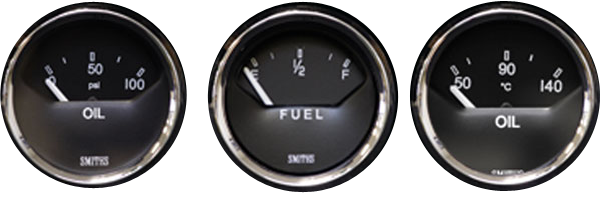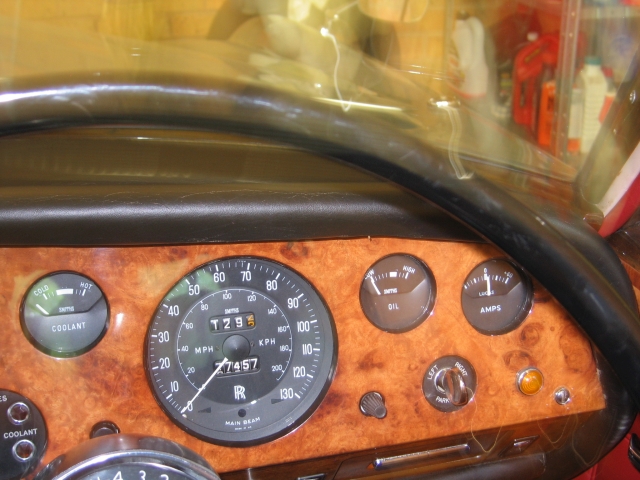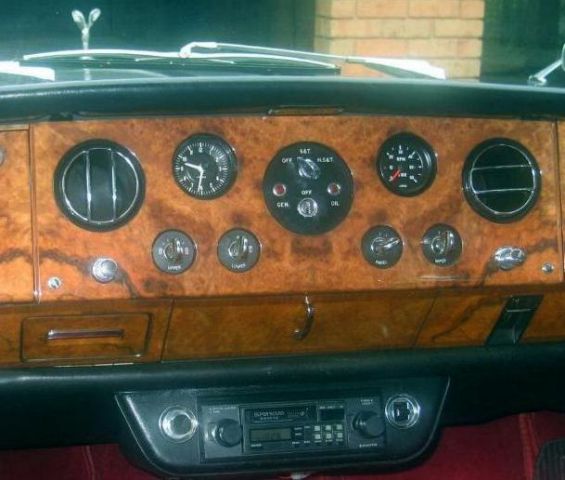| Author | Message | ||
Martin Taylor Prolific User Username: martin_taylor Post Number: 116 Registered: 7-2013 |
I have purchased and installed the correct gauge and transmitter in SRH13066, however it is not accurate, it is not fed from a regulator like a modern car. The diagram shows two resistors, one in series with the probe and one in parallel with the transmitter. Does anyone know the value of these resistors? | ||
Geoff Wootton Grand Master Username: dounraey Post Number: 1877 Registered: 5-2012 |
The value of those resisters would be very specific to the gauge you fitted. These "series 1" cars were not fitted with a coolant temperature gauge so any gauge in your car will not be standard. I fitted one to my car (SRX18501) but it just used the normal supply i.e. no external resisters. The supply on these cars is regulated - could you give us some more information. Geoff | ||
Mark Aldridge Grand Master Username: mark_aldridge Post Number: 485 Registered: 10-2008 |
Martin, what make of gauge and transmitter are you using.My Shadow has aftermarket VDO oil and temp gauges, which are fed from the ignition supply. No accuracy issues. Mark | ||
Martin Taylor Prolific User Username: martin_taylor Post Number: 117 Registered: 7-2013 |
Hi, I had an aftermarket gauge but didnít like the non standard look so purchased a used gauge from a very early shadow and the correct sender from flying spares, most other cars used a Lucas 10v regulator for the gauge supply, RR however used the battery supply which while regulated does vary a little off idle. If no one knows the value of these I guess I will have to calibrate it myself with hot water and a thermometer. | ||
Jeff McCarthy Grand Master Username: jefmac2003 Post Number: 488 Registered: 5-2007 |
Martin, I did the same thing with the original early coolant gauge. I then installed an inline adjustable regulator - a modern one, not the old Jaguar type (tried it but not accurate enough). I then got the engine up to correct running temp measured using an infra-red type gun and adjusted the gauge to show dead centre up.The regulator has an adjustable screw. Why Crewe didn't at least use a 10v regulator when everyone else using Smiths gauges did I don't know. The modern Smiths facsimiles are available and don't need a regulator. I guess they're 12v. | ||
Geoff Wootton Grand Master Username: dounraey Post Number: 1879 Registered: 5-2012 |
Hi Martin Just out of interest, where did you mount your coolant gauge. Geoff | ||
Martin Taylor Prolific User Username: martin_taylor Post Number: 118 Registered: 7-2013 |
I will remove the sensor and measure it at 88 degrees and 108, I should be able to then calculate the values with some trial and error, I figure if the middle of the gauge is thermostat temperature and the top of the white section is the danger area then that is probably all I need to know. I removed the ammeter and installed the temp gauge in its place. | ||
Paul Yorke Grand Master Username: paul_yorke Post Number: 1968 Registered: 6-2006 |
Hi Martin, was it the green top transmitter? Just checking  | ||
Martin Taylor Prolific User Username: martin_taylor Post Number: 119 Registered: 7-2013 |
Thanks Paul, it is, I have it measuring the coolant temperature in the intake manifold as there was no place in the head to fit it, I will calibrate it and update this site with the resistor values since no one seems to know them. | ||
Martin Taylor Prolific User Username: martin_taylor Post Number: 127 Registered: 7-2013 |
Geoff, I have installed it in place the ammeter | ||
Glen Poolen Yet to post message Username: wgipps Post Number: 1 Registered: 3-2018 |
Following this topic with interest. Would like to install a coolant temp gauge. Does anyone know where i can find an original gauge? | ||
Jeff McCarthy Grand Master Username: jefmac2003 Post Number: 501 Registered: 5-2007 |
Caerbont Industries UK now manufacture copies of the Shadow 52mm gauges in their "Cobra" series, including a Coolant gauge. Unlike the originals these are 12volt gauges and do not need an aftermarket voltage regulator to make them even vaguely accurate! Jaguar installed the 10v regulator in their cars in the instrument circuit but Crewe never bothered - one of the reasons the original temperature gauge read so wildly high. They fit into the dash perfectly although they are mounted slightly differently, this is of course not visible once the walnut is installed. The Smiths decal on the gauges is more visible on the new ones but this can be dealt with by the use of masking tape and a black permanent marker if it really bothers you. They can also be ordered with black bezels instead of chrome. https://www.smiths-instruments.co.uk/cobra  | ||
Patrick Lockyer. Grand Master Username: pat_lockyer Post Number: 1879 Registered: 9-2004 |
Cant understand the need for a temp gauge. The loss of coolant puts the low coolant warning light on. If the car coolant starts to boil through thermostat failure the thermostat fails in the safe open flowing of coolant.[melting the lead plugs] A buzzer kicks in if the temp of the coolant still rises. Any head gasket failure or a blocked rad would lower the coolant level putting the warning light etc on. This system can be checked with the ignition on by pressing the fuel oil level switch. | ||
Jeff McCarthy Grand Master Username: jefmac2003 Post Number: 503 Registered: 5-2007 |
Patrick, with the age of these engines some of us just feel better being able to keep an eye on symptoms before they get to the failure of critical components stage. I'd argue that replacing a truly pointless ammeter with a functioning coolant gauge (as in almost every new car since the 1950s) at least gives most drivers some point of reference in servicing the vehicles. Besides, at least for me, part of the fun is learning how these quirky beasts behave :-) | ||
Patrick Lockyer. Grand Master Username: pat_lockyer Post Number: 1880 Registered: 9-2004 |
Jeff I would go to say that the original system without a temp gauge is a better way for detecting a cooling faults before damage occurs through overheating. The less the spirited driver has to look at gauges on route can only be good for road safety with the volume of traffic in todays world. Yes many moderns since the fifties have temp gauges and many are seen by the side of the road with damage to engines with overheating issues. Now if they had a RR low coolant warning light to alert the driver!..... BTW some of the gauges that I have seen fitted look horrible and are not in keeping with the other original types fitted. IMO the amp gauge is a real help in the service dept if read correctly, not just for showing a charge! | ||
Jeff McCarthy Grand Master Username: jefmac2003 Post Number: 507 Registered: 5-2007 |
As has been discussed here, in Tee One and elsewhere endlessly: yes the emergency alarm is useful. However by the time it triggers you may well have a cooked engine; especially if you can't stop immediately! I have also fitted an engine saver alarm in case of sudden coolant loss. Better in my book to have well set up gauge that might give an early indication of something not quite right. An occasional glance at a gauge - especially if something else is making itself felt - is hardly going to cause carnage on the roads: I'll just assume you're taking the proverbial with that argument; otherwise the authorities would be panic recalling every single car on the road as a clear and present danger to the survival of the species. Statuesque blondes on the footpath probably cause more chaos. The thermostats, as also discussed to the point of terminal ennui are also not foolproof. Nothing is. Crewe installed the Coolant gauge originally and the Ammeter was a Heath Robinsonesque workaround to fill the vacant hole in the dash; and then only because customers weren't used to hot running engines - one of their more crackpot decisions under stressful production pressure no doubt. And the one thing the ammeter won't tell you is voltage - unless you're doing formulae in your head with rough estimations from the dial instead of watching where you're going! In any case many of us have decided to re/install a coolant gauge and the only useful discussion is sharing how we've gone about doing it. | ||
John Kilkenny Prolific User Username: john_kilkenny Post Number: 280 Registered: 6-2005 |
Jeff, I must disagree with your comment referring to the Ammeter as "truly pointless" It provides valuable information on the health of the electrical system and and can give advance warning of degradation of the alternator or battery.For older cars like the SS1 the more information on performance the better and I would prefer to know the current rather than the voltage. Early Shadows had both coolant and current gauges and in my opinion a more attractive Dashboard not by any measure to be considered Heath Robinson. And for additional performance information I have replaced the Cigar Lighter in the centre of the Dashboard with a 2-inch Tachometer. Here is part of the Dashboard of SRH1405. John  | ||
Geoff Wootton Grand Master Username: dounraey Post Number: 1949 Registered: 5-2012 |
In my opinion the early Shadow dashboards were by far the best. I believe it was US regulations that forced RR to change them and introduce more padding which, if true, was a pity. | ||
Jeff McCarthy Grand Master Username: jefmac2003 Post Number: 508 Registered: 5-2007 |
You are of course right in some respects John regarding what an ammeter can do - although for personal preference I've chosen a voltmeter and an oil pressure gauge (discretely on the lower dash between the steering wheel and the centre console) The voltmeter I prefer because, while it's less specific with regards the big end of the electrical system, it helps me isolate all the little leaks and annoyances and keep a rough eye on the battery state. Between that and my multimeter I've got her home few times. As I mentioned in another thread I keep the circuit ammeter wires accessible for diagnostics but have never needed them. I've gone over almost every wire, connection device, solenoid and motor over the last 10 years and am still finding either missed intermittent faults or earlier mistakes I made. The one time the voltage regulator failed was an annoyance but easy enough to trace. Unlike my first major trip with its sudden fountain of coolant gushing from the radiator. I too like the original dash and the extra info from the gauges - but I suspect many original owners wouldn't have had a clue what an ammeter was indicating on the rare occasions the needle moved. But then few probably knew much more than what was in the handbook. To each their own though - they are very personal pets these machines. | ||
Brian Vogel Grand Master Username: guyslp Post Number: 2579 Registered: 6-2009 |
Geoff Wootton wrote: "In my opinion the early Shadow dashboards were by far the best. I believe it was US regulations that forced RR to change them and introduce more padding which, if true, was a pity." Geoff, I completely agree that the earlier dash was far more beautiful than the two-series dash. I cannot recall what the knee roll area is like on the one-series, but that would have been the only area where major padding changes might have been needed. The dash surround on the one-series (or at least as pictured here) is not at all dissimilar to what's on the two-series. I wish the upper portion of the dash had been maintained as it was. My suspicion is that it was a cost cutting measure, as a lot less wood is involved in the two-series dash along with the labor to match and veneer it. There's more plastic below and lots of leather in the knee roll area. Given the precarious state of Rolls-Royce Motorcars in the 1970s I doubt that anyone could doubt that the bean counters had their influence on design decisions then much as they still do today. Today, however, RR is flush with cash and raking in more of it all the time, so "wretched excess" (sometimes literal - like the fiber-optic starlight roof) has taken over and can whims can be easily supported. Brian | ||
John Kilkenny Prolific User Username: john_kilkenny Post Number: 281 Registered: 6-2005 |
Here is another shot of the SRH1405 Dashboard with the Cigar Lighter replaced by a Tachometer.  |